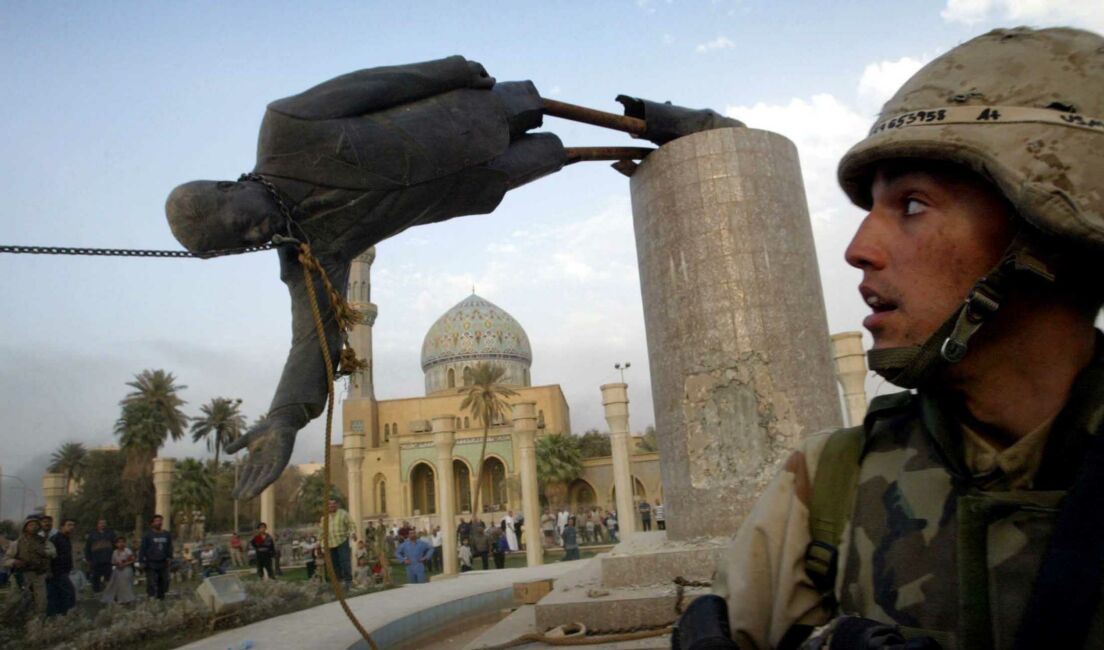The impact of an image, choosing discussion over reaction, and 5 more links worth your time
Knocking Down the Past

Are you old enough to remember this picture? When I think about the Iraq War, it is the image I associate with it. Whatever happened before April 9, 2003 and whatever happened after that day, I can’t disentangle that image from my memory of the war.
Maybe you’re familiar with the painting of New Yorkers pulling down the statue of King George III on July 9, 1776 after the Declaration of Independence was read for the first time in New York City. I wasn’t there (and neither was the artist, Johannes Oertel, who was born in Bavaria almost 50 years later), but when I look at that painting, I have a strong feeling of the significance of toppling a statue of the king after declaring independence from Great Britain.
An image can be worth more than words
There are many forms of protest and pulling down statues has undeniable impact: the visual of a statue falling from its pedestal has a symbolism that resonates with us, whether we approve of the act or condemn it. Monuments and statues are very visible reminders of the past. And, like many symbols of the past, the same statue can seem like a good thing to some and a bad thing to others.
Erin Thompson, a professor of art history at John Jay College of Criminal Justice, recently told the New York Times, “We have as humans been making monuments to glorify people and ideas since we started making art, and since we started making statues, other people have started tearing them down.” She cites “knocking down a statue” as a form of rebellion that was documented as early as 2700 B.C.
In the past few weeks, protesters—or “vandals,” “domestic terrorists,” “activists” (I’ve seen all these words used to describe the same people)—have defaced or toppled statues of Christopher Columbus, Robert E. Lee, Hans Christian Heg (an abolitionist), and Miguel de Cervantes (the Spanish writer). Dozens more have been removed by municipalities, states, and federal authorities. Whatever your point of view on Robert E. Lee and Hans Christian Heg and Cervantes, it is difficult to imagine a clear, thoughtful narrative that encompasses all three as perpetrators of a single crime we should condemn.
But we can still choose words over images
Of course, for the most part, we’re not having clear, thoughtful discussions about why people remove statues. That’s because the images of monuments being toppled (or beheaded and toppled in the case of Heg) engender a strong response. And that is intentional, whether the “topplers” are newly declared “rebels” against their king in New York in 1776, the United States Marine Corps in Baghdad in 2003, or protesters in Madison, Wisconsin in 2020.
But there are plenty of important issues that do demand thoughtful discussion on this subject. Are statues a form of free speech? Should the government, at any level, display monuments that are paid for with private or public dollars? Do these statues, however we feel about them, constitute necessary reminders of our history and is their removal detrimental to an understanding of ourselves as a people (flaws and all)?
In our 5 links this week, we’ve gathered different points of view on these questions. I hope you’ll find something here that challenges you and encourages you to start those discussions with friends and family.
5 more links worth your time
- ‘Strategic’ or ‘misguided’? Toppling of statues sparks latest debate on Madison protests, Wisconsin State Journal – On June 23rd, protesters in Madison, Wisconsin tore down a statue of an abolitionist and another that had come to represent women’s rights. Those who took the statues down acknowledge the positive message of the monuments but argue that their removal was “strategic” while others disagree and believe the act was counterproductive.
- Legally, Confederate statues in public spaces aren’t a form of free speech, The Washington Post – Two political scientists consider claims that Confederate statues must be preserved because of “First Amendment concerns.” They share their findings in this opinion piece and note that public statues are government speech, not free speech.
- What Does It Mean to Tear Down a Statue? The New York Times – An interview with the country’s foremost (and possibly only) expert on art crime about the recent destruction of statues across the country and around the world.
- The Fight against Statues Is a Fight against Civilization, National Review – Conrad Black argues that legitimate protests have been hijacked by “domestic terrorists” who are not just attacking individual statues but civilization itself.
- All Statues Should Be Private, Reason – Encouraging us to “let private groups celebrate their fandom on their own dime, and on their own property,” J.D. Tuccille concludes that “at a time when everything is up for grabs and Americans agree on exactly nothing,” the best solution to the issue of statue-toppling and vandalism is to remove them from the public arena altogether.
p.s. If you’ve got a political, ideological, or philosophical issue you’ve been considering, email me at jennifer@civilsquared.org and I’ll work with my team to put together a list of articles, issues, and interesting points of view to share with you and others.
Photo by Goran Tomasevic / REUTERS on Adobe Stock